Photovoltaic Pixels for Neural Stimulation: Circuit Models and Performance
- PMID: 25622325
- PMCID: PMC6497060
- DOI: 10.1109/TBCAS.2014.2376528
Photovoltaic Pixels for Neural Stimulation: Circuit Models and Performance
Abstract
Photovoltaic conversion of pulsed light into pulsed electric current enables optically-activated neural stimulation with miniature wireless implants. In photovoltaic retinal prostheses, patterns of near-infrared light projected from video goggles onto subretinal arrays of photovoltaic pixels are converted into patterns of current to stimulate the inner retinal neurons. We describe a model of these devices and evaluate the performance of photovoltaic circuits, including the electrode-electrolyte interface. Characteristics of the electrodes measured in saline with various voltages, pulse durations, and polarities were modeled as voltage-dependent capacitances and Faradaic resistances. The resulting mathematical model of the circuit yielded dynamics of the electric current generated by the photovoltaic pixels illuminated by pulsed light. Voltages measured in saline with a pipette electrode above the pixel closely matched results of the model. Using the circuit model, our pixel design was optimized for maximum charge injection under various lighting conditions and for different stimulation thresholds. To speed discharge of the electrodes between the pulses of light, a shunt resistor was introduced and optimized for high frequency stimulation.
Figures
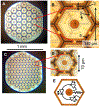



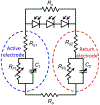



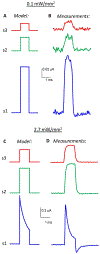

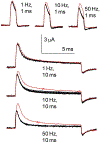
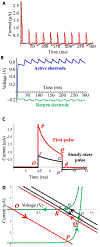
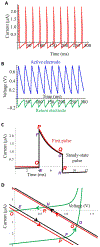

References
-
- House WF and Urban J, “Long term results of electrode implantation and electronic stimulation of the cochlea in man,” Ann. Otology, Rhinology, Laryngology, vol. 82, pp. 504–17, 1973. - PubMed
-
- Zierhofer C, Hochmair-Desoyer I, and Hochmair E, “Electronic design of a cochlear implant for multichannel high-rate pulsatile stimulation strategies,” IEEE Trans. Rehabil. Eng, vol. 3, pp. 112–116, 1995.
-
- Kringelbach ML, Jenkinson N, Owen SL, and Aziz TZ, “Translational principles of deep brain stimulation,” Nature Rev. Neurosci, vol. 8, pp. 623–635, 2007. - PubMed
-
- Kessler TM, Buchser E, Meyer S, Engeler DS, Al-Khodairy AW, Bersch U, Iselin CE, Roche B, Schmid DM, Schurch B, Zrehen S, and Burkhard FC, “Sacral neuromodulation for refractory lower uri-nary tract dysfunction: results of a nationwide registry in Switzerland,” Eur Urol, vol. 51, no. 5, pp. 1357–63, 2007. - PubMed

